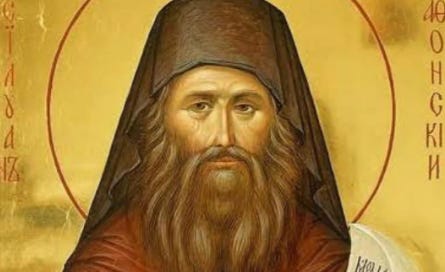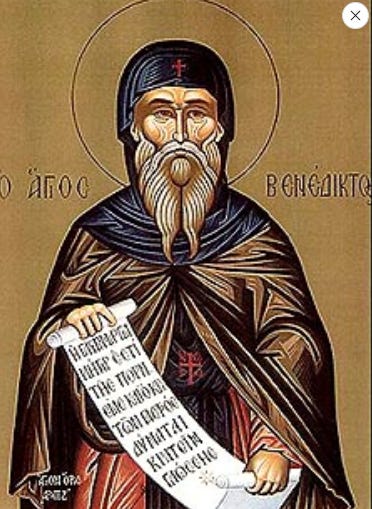Genesis 5:32-6:8 (Vespers, 1st reading)
32 And Noah was five hundred years old, and Noah begot Shem, Ham, and Japheth.
1 Now it came to pass, when men began to multiply on the face of the earth, and daughters were born to them,
2 that the sons of God saw the daughters of men, that they were beautiful; and they took wives for themselves of all whom they chose.
3 And the Lord said, “My Spirit shall not strive with man forever, for he is indeed flesh; yet his days shall be one hundred and twenty years.”
4 There were giants on the earth in those days, and also afterward, when the sons of God came in to the daughters of men and they bore children to them. Those were the mighty men who were of old, men of renown.
5 Then the Lord saw that the wickedness of man was great in the earth, and that every intent of the thoughts of his heart was only evil continually.
6 And the Lord was sorry that He had made man on the earth, and He was grieved in His heart.
7 So the Lord said, “I will destroy man whom I have created from the face of the earth, both man and beast, creeping thing and birds of the air, for I am sorry that I have made them.”
8 But Noah found grace in the eyes of the Lord.
Proverbs 6:20-7:1 (Vespers, 2nd reading)
20 My son, keep your father’s command, and do not forsake the law of your mother.
21 bind them continually upon your heart; tie them around your neck.
22 When you roam, they will lead you; when you sleep, they will keep you; and when you awake, they will speak with you.
23 For the commandment is a lamp, and the law a light; reproofs of instruction are the way of life,
24 to keep you from the evil woman, from the flattering tongue of a seductress.
25 Do not lust after her beauty in your heart, nor let her allure you with her eyelids.
26 For by means of a harlot a man is reduced to a crust of bread; and an adulteress will prey upon his precious life.
27 Can a man take fire to his bosom, and his clothes not be burned?
28 Can one walk on hot coals, and his feet not be seared?
29 So is he who goes in to his neighbor’s wife; whoever touches her shall not be innocent.
30 People do not despise a thief if he steals to satisfy himself when he is starving.
31 Yet when he is found, he must restore sevenfold; he may have to give up all the substance of his house.
32 Whoever commits adultery with a woman lacks understanding; he who does so destroys his own soul.
33 Wounds and dishonor he will get, and his reproach will not be wiped away.
34 For jealousy is a husband’s fury; therefore he will not spare in the day of vengeance.
35 He will accept no recompense, nor will he be appeased though you give many gifts.
1 My son, keep my words, and treasure my commands within you.
Venerable Benedict of Nursia
Saint Benedict, founder of Western monasticism, was born in the Italian city of Nursia in the year 480. When he was fourteen years of age, the saint’s parents sent him to Rome to study. Unsettled by the immorality around him, he decided to devote himself to a different sort of life.
At first Saint Benedict settled near the church of the holy Apostle Peter in the village of Effedum, but news of his ascetic life compelled him to go farther into the mountains. There he encountered the hermit Romanus, who tonsured him into monasticism and directed him to live in a remote cave at Subiaco. From time to time, the hermit would bring him food.
For three years the saint waged a harsh struggle with temptations and conquered them. People soon began to gather to him, thirsting to live under his guidance. The number of disciples grew so much, that the saint divided them into twelve communities. Each community was comprised of twelve monks and was a separate skete. The saint gave each skete an igumen from among his experienced disciples, and only the novice monks remained with Saint Benedict for instruction.
The strict monastic Rule Saint Benedict established for the monks was not accepted by everyone, and more than once he was criticized and abused by dissenters.
Finally he settled in Campagna and on Mount Cassino he founded the Monte Cassino monastery, which for a long time was a center of theological education for the Western Church. The monastery possessed a remarkable library. Saint Benedict wrote his Rule, based on the experience of life of the Eastern desert-dwellers and the precepts of Saint John Cassian the Roman (February 29).
The Rule of Saint Benedict dominated Western monasticism for centuries (by the year 1595 it had appeared in more than 100 editions). The Rule prescribed the renunciation of personal possessions, as well as unconditional obedience, and constant work. It was considered the duty of older monks to teach the younger and to copy ancient manuscripts. This helped to preserve many memorable writings from the first centuries of Christianity.
Every new monk was required to live as a novice for a year, to learn the monastic Rule and to become acclimated to monastic life. Every deed required a blessing. The head of this cenobitic monastery is the igumen. He discerns, teaches, and explains. The igumen solicits the advice of the older, experienced brethren, but he makes the final decisions. Keeping the monastic Rule was strictly binding for everyone and was regarded as an important step on the way to perfection.
Saint Benedict was granted by the Lord the gift of foresight and wonderworking. He healed many by his prayers. The monk foretold the day of his death in 547. The main source for his Life is the second Dialogue of Saint Gregory.
Saint Benedict’s sister, Saint Scholastica (February 10), also became famous for her strict ascetic life and was numbered among the saints.
Fast and Liturgy
by Fr. Alexander Schmemann
Fasting and Eucharist form, so to say, two complimentary and necessary poles of Church life, manifest the essential antinomy of her nature: expectation and possession, fullness and growth, eschatology and history.
The liturgical rules of the Orthodox Church prescribe that the Divine Liturgy is to be celebrated after Vespers on certain fast days. These days are: Thursday and Saturday of the Holy Week, the eves of Christmas and Theophany and the Feast of the Annunciation. Likewise the Liturgy of the Presanctified Gifts is always celebrated after Vespers. If we bear in mind that our Typikon determines the time for Vespers according to the sun and not by the clock, then the prescribed time for these evening Liturgies should be approximately from two to five in the afternoon.
It is well known that these rubrics have become dead letter today, or rather they are preserved in form, but in such a way that the Liturgy is not transferred to the evening, but on the contrary, Vespers is served in the morning. This breach of rule should not be explained as a mere condescension of the Church to the “weakness of the flesh,” as a desire to curtail the period of abstinence for the communicants, for we can observe this same practice where the rubrics are scrupulously respected and where no attempt is made to defer to human weakness. In this case, we are forced to deal with the belief, deeply rooted in contemporary ecclesiastical consciousness, that the Divine Liturgy must always be celebrated in the morning. Its vesperal celebration would appear to be an unheard of innovation to the overwhelming majority of Orthodox people, something much more unnatural and irregular than the well-established practice of serving Vespers in the morning and Matins in the evening.
It is obvious however, that in uniting the Liturgy with Vespers, the authors of the Typikon intended more than a purely formal connection between the two services. They meant a deliberate transfer of the Liturgy to the evening, a conscious change in the usual order of services. Again it is obvious that in not fulfilling the rule, or in fulfilling it only as a formality (i.e., in transferring Vespers to the morning) we commit a twofold infraction of the liturgical “typos”; we serve an evening service in the morning which besides being a “nominalization” of prayer, is a contradiction to the common sense, and moreover, we completely ignore the reasons which promoted the Church to order the celebration of the Liturgy on certain days in the evening and not in the morning. But perhaps if we investigate these reasons, we will see in them something more meaningful than a mere detail of rubrics, something forgotten yet essential for the comprehension of our liturgical tradition.
This week’s calendar reminders:
Monday 3/10: Lenten Matins 8:30 am
Tuesday 3/11: no services or events
Wednesday 3/12: Presanctified Liturgy 6:30 pm
Thursday 3/13: Lenten Matins 8:30 am
Friday 3/14: Paraklesis to the Theotokos 8:30 am
Saturday 3/15: Catechumen Class 4:30 pm; Choir Rehearsal 5 pm; Great Vespers 6 pm
Sunday 3/16: Divine Liturgy 9:15am;
CLICK BELOW to donate online:
Christ the Savior Orthodox Church is located in Southbury, Connecticut, and is part of the New England Diocese of the Orthodox Church of America.
Mailing address: Christ the Savior Church, 1070 Roxbury Road, Southbury, CT 06488
PLEASE DONATE to help our parish do the work of the Lord, thrive and grow, and extend the Kingdom of God. May the Lord bless your generosity!
Fr. Moses Locke can be reached at frmoseslocke@gmail.com











